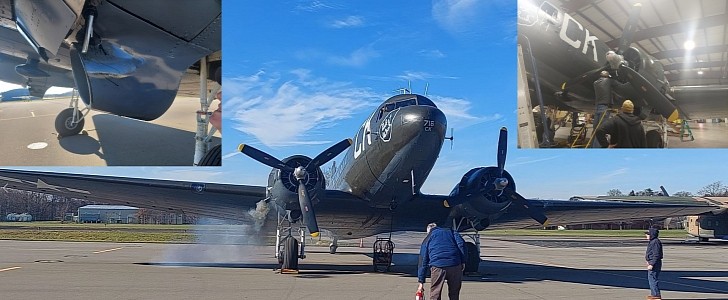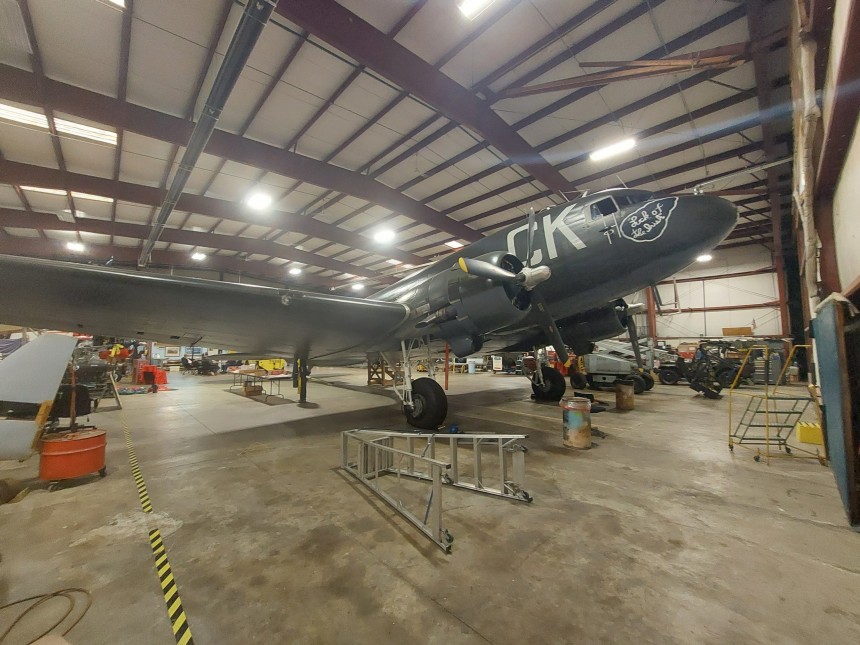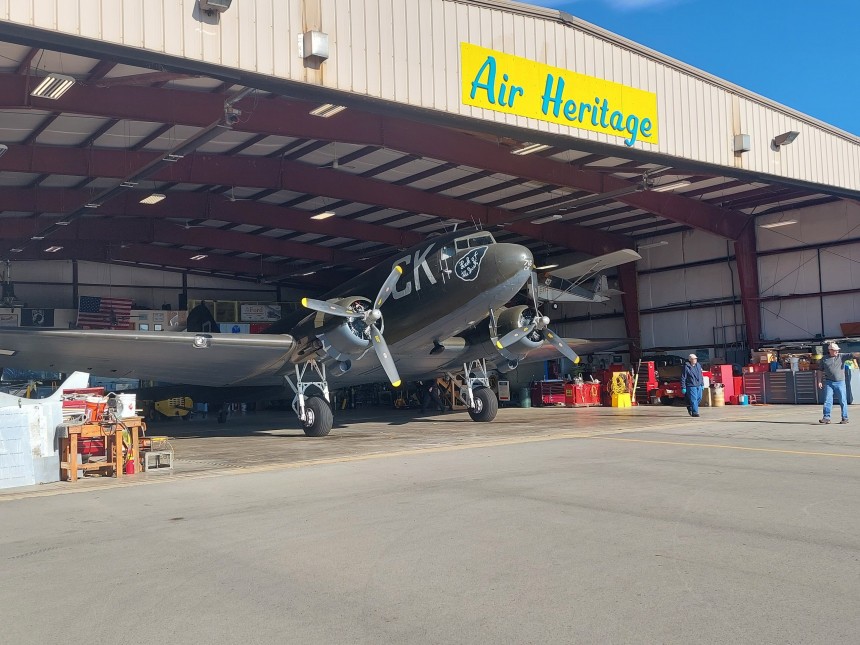Not every aerospace museum needs to take up four hangars and a few hundred thousand square feet to be worth visiting. If anything, smaller museums can have a charm all their own. It's our delight to bring you another hidden gem museum that not only flies what they exhibit, but also maintains them year-round.
Welcome to the Air Heritage Museum on the grounds of the Beaver County Municipal Airport in Beaver Falls, Pennsylvania. Let's be honest. This is not the kind of place you go to see one-off experimental psycho-planes, like the National Airforce Museum in Ohio or the Smithsonian Air & Space Museum in Washington D.C. But if airworthy warbirds are your thing, it doesn't get much better than what the staff at Air Heritage get up to every day.
The museum facility consists of one, count it, one main hangar with a few thousand square feet of tarmac out front that leads to the airport runway. Those who saw our visit to the tiny American Airpower Museum a few weeks ago know size isn't all that matters in these cases. It's all about what you can manage to fit inside. Museum staff can have as many as three to four full-sized warbirds on display in and around the main hangar at any given time.
What the museum lacks in quantity is made up for in spades with the quality of what they manage to squeeze inside. The museum has its origins as a historical research and preservation society. It was a gender-inclusive gentleman's club of sorts. One where people could gather and express their passion for old American warplanes. Over the last 35 years, many among museum staff were once airmen or some other form of Air Force personnel. Others even helped manufacture the planes themselves. Past exhibits include B-17 and B-25 bombers and a mid-engined Bell P-39 Aerocobra.
It all started in earnest in April 1986. The first addition to the collection was a meager L-21B, the militarized version of the lowly Piper Super Cub. Not exactly a jet fighter, but a cornerstone for a facility where jet fighters would one day sit on display. The F-15A Eagle and F-4 Phantom II parked outside the runway were still in full-blown military service when the museum first opened its hangar doors, as were the plethora of now disused Bell UH-1 Huey helicopters. One and all now enjoy their retirement watching nervous student pilots take off in their Cessnas within eyesight of the museum.
The stars of the show share time within the hangar proper. A pristine North American T-6 Texan Second World War trainer is on a more permanent stay. Splitting time inside the remaining space is the very last Fairchild C-123K Provider heavy transport aircraft left flying on the planet. Such a neat find deserves a showcase all its own. Check back soon for that! For now, let's focus on the third plane in this old-school trifecta. A certifiably gorgeous Douglas C-47B Skytrain lovingly christened Luck of the Irish.
This isn't a cheap replica. Luck of the Irish legitimately flew combat personnel during the decisive Battle of the Bulge. The battle would be the final major offensive by the German Army of World War Two. It also towed Waco assault gliders into combat while simultaneously dropping troops during Operation Varsity.
Hundreds of thousands in donations and thousands of hours of labor restored the disused Skytrain into a machine that can legitimately make that money back at air shows. The plane flies fairly routinely and must be maintained as such. Ultra-thick 140 weight oil regularly leaks from the twin Pratt & Whitney R-1930 radial engines that help the plane cruise at around 160 miles per hour (257 kph) at altitudes of 20,000 feet (6,096 meters).
Arrive early enough, and you may even catch the staff diagnosing and fixing a problem of too much oil pooling in the bottom-most cylinder. A few sparkplugs, elbow grease, and a few muffled swear words got things in order for the aircraft's last cold-start before the winter. The manually opening hangar doors swung open that bright fall afternoon like the parting of some aircraft-sized holy sea. Before long, the team's trusty air tug had the great beast out on the tarmac in a matter of a few minutes.
A whole host of personnel were on hand to make sure all went smoothly. Including an engineer in the pilot's seat, a "fireguard," which was just a man with a fire extinguisher, and another person to carry along a "start cart" that plugs directly into the C-47s main battery. This extra boost gives the lumbering twin-engined plane enough cranking amps to sputter to life like it's 1945 all over again.
It's hard to convey the type of noise a pair of these 14-cylinder 1,200 horsepower monsters firing to life sounds like, except maybe like the pits of hell opening up. All to the sound of thousands of puttering two-stroke golf carts rising from its depths. Be cautious not to get too close to the aircraft under nearly full-throttle. The sheer force of air behind them is legitimately enough to knock you off your feet.
Even so, it was a huge thrill watching a genuine piece of Second World War history spark to life with the same vigor it did during the war. Even if the not entirely fixed oil pooling issue coated the ground with thick aviation oil when the test was done. Totally worth $100 of aviation fuel and a few shop towels. Check back for more from our visit right here on autoevolution.
The museum facility consists of one, count it, one main hangar with a few thousand square feet of tarmac out front that leads to the airport runway. Those who saw our visit to the tiny American Airpower Museum a few weeks ago know size isn't all that matters in these cases. It's all about what you can manage to fit inside. Museum staff can have as many as three to four full-sized warbirds on display in and around the main hangar at any given time.
What the museum lacks in quantity is made up for in spades with the quality of what they manage to squeeze inside. The museum has its origins as a historical research and preservation society. It was a gender-inclusive gentleman's club of sorts. One where people could gather and express their passion for old American warplanes. Over the last 35 years, many among museum staff were once airmen or some other form of Air Force personnel. Others even helped manufacture the planes themselves. Past exhibits include B-17 and B-25 bombers and a mid-engined Bell P-39 Aerocobra.
It all started in earnest in April 1986. The first addition to the collection was a meager L-21B, the militarized version of the lowly Piper Super Cub. Not exactly a jet fighter, but a cornerstone for a facility where jet fighters would one day sit on display. The F-15A Eagle and F-4 Phantom II parked outside the runway were still in full-blown military service when the museum first opened its hangar doors, as were the plethora of now disused Bell UH-1 Huey helicopters. One and all now enjoy their retirement watching nervous student pilots take off in their Cessnas within eyesight of the museum.
This isn't a cheap replica. Luck of the Irish legitimately flew combat personnel during the decisive Battle of the Bulge. The battle would be the final major offensive by the German Army of World War Two. It also towed Waco assault gliders into combat while simultaneously dropping troops during Operation Varsity.
Hundreds of thousands in donations and thousands of hours of labor restored the disused Skytrain into a machine that can legitimately make that money back at air shows. The plane flies fairly routinely and must be maintained as such. Ultra-thick 140 weight oil regularly leaks from the twin Pratt & Whitney R-1930 radial engines that help the plane cruise at around 160 miles per hour (257 kph) at altitudes of 20,000 feet (6,096 meters).
Arrive early enough, and you may even catch the staff diagnosing and fixing a problem of too much oil pooling in the bottom-most cylinder. A few sparkplugs, elbow grease, and a few muffled swear words got things in order for the aircraft's last cold-start before the winter. The manually opening hangar doors swung open that bright fall afternoon like the parting of some aircraft-sized holy sea. Before long, the team's trusty air tug had the great beast out on the tarmac in a matter of a few minutes.
It's hard to convey the type of noise a pair of these 14-cylinder 1,200 horsepower monsters firing to life sounds like, except maybe like the pits of hell opening up. All to the sound of thousands of puttering two-stroke golf carts rising from its depths. Be cautious not to get too close to the aircraft under nearly full-throttle. The sheer force of air behind them is legitimately enough to knock you off your feet.
Even so, it was a huge thrill watching a genuine piece of Second World War history spark to life with the same vigor it did during the war. Even if the not entirely fixed oil pooling issue coated the ground with thick aviation oil when the test was done. Totally worth $100 of aviation fuel and a few shop towels. Check back for more from our visit right here on autoevolution.




















